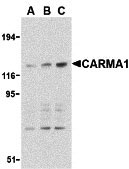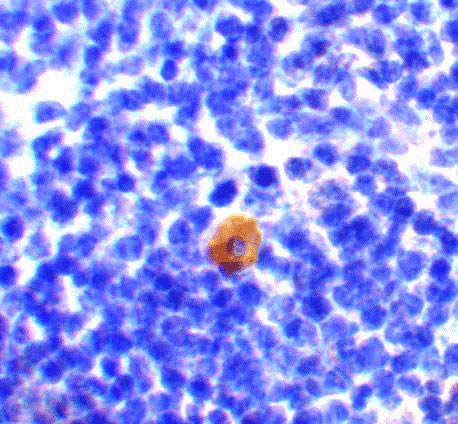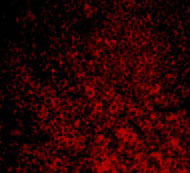CARMA1 Antibody
- SPECIFICATION
- CITATIONS
- PROTOCOLS
- BACKGROUND

Application
| WB, IHC-P, IF, E |
|---|---|
| Primary Accession | Q9BXL7 |
| Other Accession | Q9BXL7, 172046231 |
| Reactivity | Human, Mouse |
| Host | Rabbit |
| Clonality | Polyclonal |
| Isotype | IgG |
| Calculated MW | 133284 Da |
| Application Notes | CARMA1 antibody can be used for detection of CARMA1 by Western blot at 0.5 to 2 µg/mL. A band at approximately 125 kDa can be detected. Antibody can also be used for immunohistochemistry starting at 10 µg/mL. For immunofluorescence start at 20 µg/mL. |
| Gene ID | 84433 |
|---|---|
| Other Names | CARMA1 Antibody: PPBL, BENTA, BIMP3, IMD11, CARMA1, Caspase recruitment domain-containing protein 11, CARD-containing MAGUK protein 1, Carma 1, caspase recruitment domain family, member 11 |
| Target/Specificity | CARD11; |
| Reconstitution & Storage | CARMA1 antibody can be stored at 4℃ for three months and -20℃, stable for up to one year. As with all antibodies care should be taken to avoid repeated freeze thaw cycles. Antibodies should not be exposed to prolonged high temperatures. |
| Precautions | CARMA1 Antibody is for research use only and not for use in diagnostic or therapeutic procedures. |
| Name | CARD11 {ECO:0000303|PubMed:11278692, ECO:0000312|HGNC:HGNC:16393} |
|---|---|
| Function | Adapter protein that plays a key role in adaptive immune response by transducing the activation of NF-kappa-B downstream of T- cell receptor (TCR) and B-cell receptor (BCR) engagement (PubMed:11278692, PubMed:11356195, PubMed:12356734). Transduces signals downstream TCR or BCR activation via the formation of a multiprotein complex together with BCL10 and MALT1 that induces NF-kappa-B and MAP kinase p38 (MAPK11, MAPK12, MAPK13 and/or MAPK14) pathways (PubMed:11356195). Upon activation in response to TCR or BCR triggering, CARD11 homooligomerizes to form a nucleating helical template that recruits BCL10 via CARD-CARD interaction, thereby promoting polymerization of BCL10 and subsequent recruitment of MALT1: this leads to I-kappa-B kinase (IKK) phosphorylation and degradation, and release of NF-kappa-B proteins for nuclear translocation (PubMed:24074955). Its binding to DPP4 induces T-cell proliferation and NF-kappa-B activation in a T-cell receptor/CD3-dependent manner (PubMed:17287217). Promotes linear ubiquitination of BCL10 by promoting the targeting of BCL10 to RNF31/HOIP (PubMed:27777308). Stimulates the phosphorylation of BCL10 (PubMed:11356195). Also activates the TORC1 signaling pathway (PubMed:28628108). |
| Cellular Location | Cytoplasm. Membrane raft. Note=Colocalized with DPP4 in membrane rafts. |
| Tissue Location | Detected in adult peripheral blood leukocytes, thymus, spleen and liver. Also found in promyelocytic leukemia HL-60 cells, chronic myelogenous leukemia K-562 cells, Burkitt's lymphoma Raji cells and colorectal adenocarcinoma SW480 cells. Not detected in HeLaS3, MOLT-4, A-549 and G431 cells. |

Thousands of laboratories across the world have published research that depended on the performance of antibodies from Abcepta to advance their research. Check out links to articles that cite our products in major peer-reviewed journals, organized by research category.
info@abcepta.com, and receive a free "I Love Antibodies" mug.
Provided below are standard protocols that you may find useful for product applications.
Background
CARMA1 Antibody: CARMA proteins belong to the membrane-associated guanylate kinase-like (MAGUK) family of proteins that can function as molecular scaffolds that assist assembly of signal transduction molecules. CARMA1, CARMA2, and CARMA3 share high degrees of sequence and functional homology, but their tissue-specific distribution suggests that they serve distinct biological functions in different cell types. Both CARMA1 and CARMA3 associate with NEMO, the regulatory subunit of the IκK complex, thereby regulating activation of the NF-κB transcription factor. Also, gene inactivation studies showed a complete block in T and B cell immunity as well as an impaired response to LPS, indicating that CARMA1 is a critical regulator in both the adaptive and innate immune systems.
References
Fanning AS and Anderson JM. Protein modules as organizers of membrane structure.Curr. Opin. Cell Biol. 1999; 11:432-9.
Gaide O, Martinon F, Michau O, et al. Carma1, 1 CARD-containing binding partner of Bcl10, induces Bcl10 phosphorylation and NF-κ B activation. FEBS Lett. 2001; 496:121-7.
Bertin J, Wang L, Guo Y, et al. CARD11 and CARD14 are novel caspase recruitment domain (CARD)/membrane-associated guanylate kinase (MAGUK) family members that interact with BCL10 and activate NF-κ B. J. Biol. Chem. 2001; 276:11877-82.
McAllister-Lucas LM, Inohara N, Lucas PC, et al. Bimp1, a MAGUK family member linking protein kinase C activation to Bcl10-mediated NF-κB induction. J. Biol. Chem. 2001; 276:30589-97.
If you have used an Abcepta product and would like to share how it has performed, please click on the "Submit Review" button and provide the requested information. Our staff will examine and post your review and contact you if needed.
If you have any additional inquiries please email technical services at tech@abcepta.com.













 Foundational characteristics of cancer include proliferation, angiogenesis, migration, evasion of apoptosis, and cellular immortality. Find key markers for these cellular processes and antibodies to detect them.
Foundational characteristics of cancer include proliferation, angiogenesis, migration, evasion of apoptosis, and cellular immortality. Find key markers for these cellular processes and antibodies to detect them. The SUMOplot™ Analysis Program predicts and scores sumoylation sites in your protein. SUMOylation is a post-translational modification involved in various cellular processes, such as nuclear-cytosolic transport, transcriptional regulation, apoptosis, protein stability, response to stress, and progression through the cell cycle.
The SUMOplot™ Analysis Program predicts and scores sumoylation sites in your protein. SUMOylation is a post-translational modification involved in various cellular processes, such as nuclear-cytosolic transport, transcriptional regulation, apoptosis, protein stability, response to stress, and progression through the cell cycle. The Autophagy Receptor Motif Plotter predicts and scores autophagy receptor binding sites in your protein. Identifying proteins connected to this pathway is critical to understanding the role of autophagy in physiological as well as pathological processes such as development, differentiation, neurodegenerative diseases, stress, infection, and cancer.
The Autophagy Receptor Motif Plotter predicts and scores autophagy receptor binding sites in your protein. Identifying proteins connected to this pathway is critical to understanding the role of autophagy in physiological as well as pathological processes such as development, differentiation, neurodegenerative diseases, stress, infection, and cancer.




